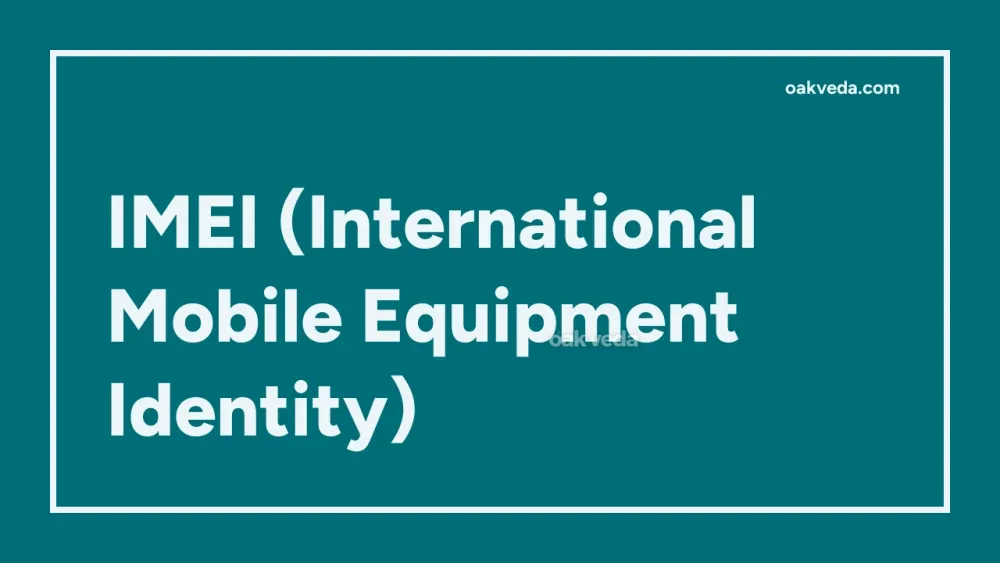
What is the Full Form of IMEI?
IMEI is the abbreviation for International Mobile Equipment Identity. This unique identifier plays a crucial role in the world of mobile telecommunications, serving as a digital fingerprint for mobile devices.
What is International Mobile Equipment Identity?
The International Mobile Equipment Identity, commonly known as IMEI, is a 15 to 17-digit code assigned to every mobile device. This code acts as a unique identifier for mobile phones, tablets, and some satellite phones, primarily those operating on GSM, UMTS, and LTE networks.
Origin and Development of IMEI
The concept of IMEI was introduced in the early 1990s with the advent of GSM technology. It was developed by the European Telecommunications Standards Institute (ETSI) to provide a standardized method for identifying mobile devices globally.
How does IMEI work?
The IMEI number works by providing a distinct identity to each mobile device. When a device connects to a network, it transmits its IMEI number, allowing the network to identify and authenticate the device. This process helps in various network operations and security measures.
IMEI Number Structure
The IMEI number typically consists of four main parts:
- Type Allocation Code (TAC): The first 8 digits
- Serial Number: The next 6 digits
- Check Digit: The final digit
- Software Version Number: Optional 2 digits (for IMEISV)
Functions of IMEI
The International Mobile Equipment Identity serves several important functions:
- Device Identification: It uniquely identifies each mobile device on cellular networks.
- Theft Prevention: IMEI can be used to block stolen devices from accessing networks.
- Network Security: It helps in preventing unauthorized access to mobile networks.
- Device Tracking: In case of loss or theft, IMEI can assist in locating the device.
Applications of IMEI
The IMEI number finds applications in various aspects of mobile technology:
- Device Authentication: Network operators use IMEI to verify the identity of devices connecting to their networks.
- Blacklisting Stolen Devices: When a device is reported stolen, its IMEI can be added to a blacklist, preventing it from connecting to networks.
- Warranty and Insurance: IMEI is often used to validate warranty claims and insurance policies for mobile devices.
- Mobile Device Management: Enterprises use IMEI for inventory management and security purposes.
Features of IMEI
Key features of the International Mobile Equipment Identity include:
- Uniqueness: Each IMEI number is unique to a specific device.
- Permanence: The IMEI is typically hardcoded into the device and cannot be changed easily.
- Standardization: IMEI follows a globally recognized format.
- Network Independence: The IMEI is separate from the SIM card and network-specific identifiers.
Benefits of IMEI
The International Mobile Equipment Identity offers several benefits:
- Enhanced Security: It helps in preventing mobile phone theft and unauthorized use.
- Improved Network Management: Network operators can better manage and monitor devices on their networks.
- Consumer Protection: IMEI aids in recovering lost or stolen devices.
- Fraud Prevention: It helps in identifying counterfeit or cloned devices.
Limitations or Challenges of IMEI
Despite its advantages, IMEI has some limitations:
- IMEI Manipulation: Some sophisticated methods can alter IMEI numbers, though this is illegal in many countries.
- Privacy Concerns: The ability to track devices via IMEI raises privacy issues.
- Limited Effectiveness: Blocking stolen devices by IMEI is not always foolproof, as numbers can be changed or devices can be used in other countries.
Future Developments in IMEI Technology
As mobile technology evolves, so does the role of IMEI:
- Integration with IoT: IMEI-like identifiers may be adapted for Internet of Things (IoT) devices.
- Enhanced Security Measures: Future developments may focus on making IMEI more tamper-resistant.
- Global Database Integration: Efforts are ongoing to create more comprehensive, global databases of IMEI numbers to combat device theft across borders.
FAQs on IMEI Full Form
-
How can I find my device's IMEI number? You can typically find your IMEI by dialing *#06# on your device, checking the device settings, or looking on the device itself (often under the battery or on the SIM tray).
-
Is it safe to share my IMEI number? While sharing your IMEI isn't inherently dangerous, it's best to be cautious and only share it with trusted parties like your mobile carrier or when filing a police report for a stolen device.
-
Can two devices have the same IMEI number? No, each IMEI number should be unique. If two devices have the same IMEI, at least one of them is likely counterfeit or cloned.
-
What should I do if my device is stolen? Report the theft to the police and your mobile carrier, providing them with your device's IMEI number so they can block the device from network access.
-
Can changing my SIM card affect my IMEI? No, the IMEI is tied to the device hardware, not the SIM card. Changing your SIM card does not alter your IMEI.
In conclusion, the International Mobile Equipment Identity (IMEI) plays a vital role in mobile device identification and security. As mobile technology continues to advance, the importance of IMEI in maintaining network integrity and protecting consumers is likely to grow, making it an essential component of our increasingly connected world.
You may be interested in:

